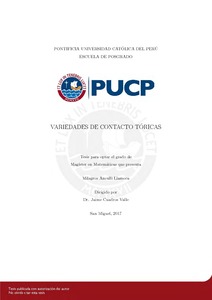| dc.contributor.advisor | Cuadros Valle, Jaime | |
| dc.contributor.author | Anculli Llamoca, Milagros | es_ES |
| dc.date.accessioned | 2018-01-25T16:03:39Z | es_ES |
| dc.date.available | 2018-01-25T16:03:39Z | es_ES |
| dc.date.created | 2017 | es_ES |
| dc.date.issued | 2018-01-25 | es_ES |
| dc.identifier.uri | http://hdl.handle.net/20.500.12404/9947 | |
| dc.description.abstract | En este trabajo se presentará un estudio de las variedades de contacto obtenidas
mediante el método de reducción de contacto, demostrado inicialmente por
Geiges e impulsado por él mismo, E. Lerman entre otros. Dicho resultado
tiene su esencia en el teorema de reducción simpléctica demostrado por K. R.
Meyer en 1973 e independientemente por J. Marsden y A. Weinstein en 1974.
Ambas contribuciones a la mecánica clásica impulsaron que en los últimos
años se busque generalizar estos resultados al caso de contacto. Por ello, se
pone mucha atención en el tipo de grupo de automorfismos que actuará en
la variedad de estudio, con el objetivo de encontrar mayor información de la
estructura de las variedades obtenidas luego de la reducción. La particularidad
en los ejemplos que desarrollaremos será en que el grupo actuando en
muchos casos será un toro de una cierta dimensión, lo cual nos generará las
llamadas variedades teóricas de contacto. | es_ES |
| dc.description.abstract | In this work, we will study contact manifolds obtained through the contact
reduction method, initially demonstrated by Geiges and promoted by himself,
E. Lerman among others. This result has its essence in the symplectic
reduction theorem demonstrated by K. R. Meyer in 1973 and independently
by J. Marsden and A. Weinstein in 1974. Both contributions to classical
mechanics led to the search of generalization of these results to the contact
case over the last few years. Therefore, a lot of attention is paid to the type
of group of automorphisms that will act in the study manifold, with the aim
of nding more information on the structure of the manifolds obtained after
the reduction. The particularity in the examples that we will develop will be
that the group acting in many cases will be a torus of a certain dimension,
which will generate the so-called contact toric manifolds. | es_ES |
| dc.description.uri | Tesis | es_ES |
| dc.language.iso | eng | es_ES |
| dc.publisher | Pontificia Universidad Católica del Perú | es_ES |
| dc.rights | info:eu-repo/semantics/openAccess | es_ES |
| dc.rights.uri | http://creativecommons.org/licenses/by-nc-nd/2.5/pe/ | * |
| dc.subject | Variedades simplécticas | es_ES |
| dc.subject | Sistemas hamiltonianos | es_ES |
| dc.subject | Variedades | es_ES |
| dc.subject | Variedades | es_ES |
| dc.title | Variedades de contacto tóricas | es_ES |
| dc.type | info:eu-repo/semantics/masterThesis | es_ES |
| thesis.degree.name | Maestro en Matemáticas | es_ES |
| thesis.degree.level | Maestría | es_ES |
| thesis.degree.grantor | Pontificia Universidad Católica del Perú. Escuela de Posgrado | es_ES |
| thesis.degree.discipline | Matemáticas | es_ES |
| renati.discipline | 541137 | es_ES |
| renati.level | https://purl.org/pe-repo/renati/level#maestro | es_ES |
| renati.type | http://purl.org/pe-repo/renati/type#tesis | es_ES |
| dc.publisher.country | PE | es_ES |
| dc.subject.ocde | https://purl.org/pe-repo/ocde/ford#1.01.00 | es_ES |






